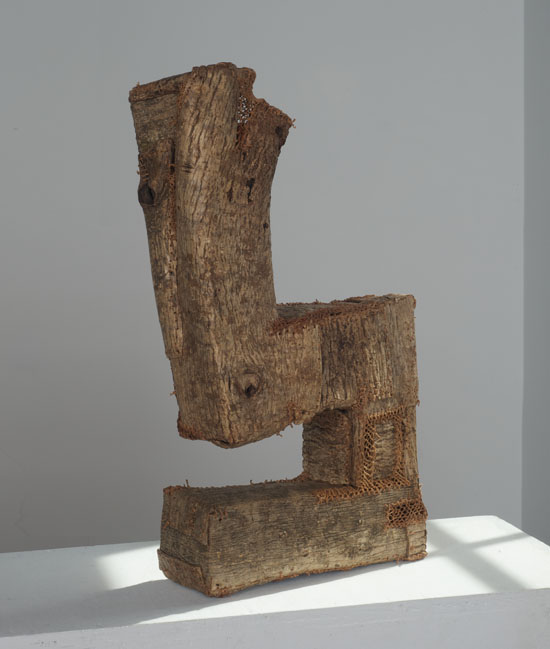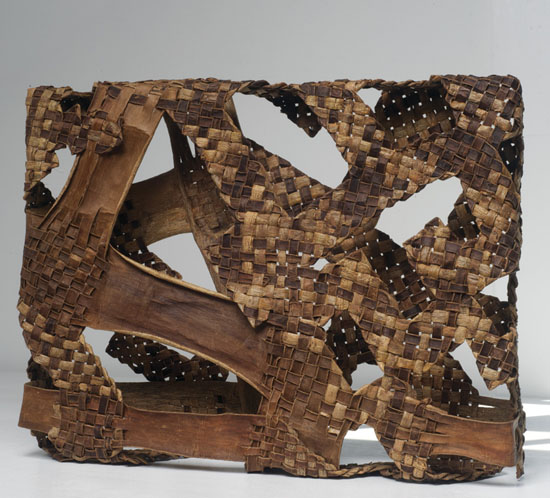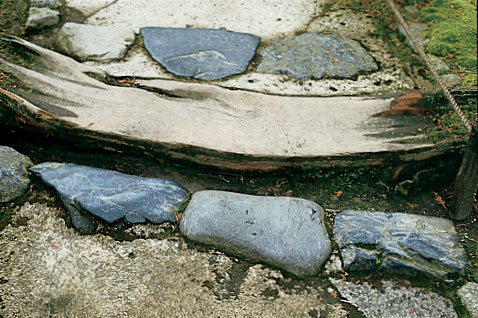Japanese Bamboo Art: The Abbey Collection, is the first show at the Metropolitan Museum of Art in New York to concentrate on basketry, it features works of Japanese bamboo art dating from the late 19th century to the present—the period when basketry in Japan became recognized as an art form that transcends “craft.” The exhibition showcases more than 80 bamboo baskets and sculptures created by accomplished artists, including all six masters who have received the designation “Living National Treasure.” It celebrates the promised gift to the Met of more than 70 mostly extraordinary bamboo baskets and sculptures from the New York collectors Diane and Arthur Abbey. The exhibition also includes a site-specific installation, The Gate, by Tanabe Chikuunsai IV, a fourth-generation bamboo artist born in 1973, meandering forms, that Roberta Smith says have “an animated-cartoon energy and snap; they cavort almost wickedly.” “Throughout the exhibition,” Smith continues. ” you will see basketry abstracted, deconstructed and all but exploded in the hands of successive generations of artists.” The exhibition will be open through February 2018 — it is not to be missed.
A number of the artists exhibited by browngrotta arts have frequently worked with bamboo. Jiro Yonezawa , awarded the Lloyd Cotsen Bamboo Prize in 2006, is a master — creating vessels, seductive objects and human-size sculptures.
” a compendium of information that is not likely to be soon duplicated.” She is also the creator of works that combine bamboo and waxed linen. “I met Tanabe-san on the first tour,” Bess writes. “He is a lovely young man.” The entry piece in Japanese Bamboo Art: The Abbey Collection is “ spectacular” in Bess’s view. The artist/author met Yamagishi-san who provided the Tiger Bamboo in the Met exhibition and from which The Gate is made, when she was researching the book. “Interestingly,” Bess writes, “if you take a rhizome of his tosatorafudake (tiger bamboo from Tosa, had to show off a bit) and plant it anywhere else, the skin does not develop the distinctive tiger markings!”
The exhibition will be open through February 2018 — it is not to be missed. For more information on the show click here. The show’s catalog is available in The Met’s online store here.
Japanese artist Mutsumi Iwasaki passed away on April 11, 2013. browngrotta arts has promoted Mutsumi’s meticulously constructed forms since 2006. After working as a textile artist for nearly two decades, in 1998, Iwasaki began making both baskets and her own paper. In 2000, her new work was included in the influential In Our Hands Exhibition, in Nagoya, Japan. “I make works in which elements are “piled,” she explained in our 2011 catalog, Stimulus: Art and Its Inception. “They are like small boxes of air and a record of the everyday. I use washi paper that I make myself as the main material. When I use commercial paper I feel the difference in the material.” An illustrated interview with Iwasaki in Japanese appears at: http://www.isogaya.co.jp/artist/iwasaki-mutsumi/iwasaki-m-rireki.htm. With the help of an online translator, you can learn a bit more about her approach, which included adding paraffin to paper made of Japanese mulberry to create thickness. “I liked that the experiment changed the look of the material,” Iwasaki told interviewer, Jinnai Ritsuko in 2008.
Sculptures of bark by Masako Yoshida are among the works that browngrotta arts will feature at SOFA NY. The constructions Yoshida envisions are built by interlacing sheets of walnut bark with string made of nettle. “I consider myself a member of society who wants to make works that open into the new world earnestly, one step at a time,” Yoshida finds that her work provides her “a means of release, allowing the truth to emerge and open the mind. In the process, I ask myself, ‘what is my connection to society?'” Yoshida has studied basketmaking with noted teacher and artist, Hisako Sekijima.

11my Kuu#441, Masako Yoshida;, walnut and maple, 20.5″ x 12″ x 4.25″, 2007-2010, photo by Tom Grotta
She graduated from Musashino Art University, majoring in textiles and has since worked there as instructor. She has also taught at Tamagawa Institute. Her work has been exhibited at the Nagoya Trade and Industry Center (In Our Hands) Japan; Iwasaki Museum of Art, Yokohama, Japan; Megro City Museum, Japan; Takashimaya Department Store (Amu Kumu solo exhibition); Tachikawa, Japan; Nuno Annex Exhibition (solo, traveling exhibition); Wayne Art Center, Pennsylvania (Green for the Get Go).
Japanese artist Hisako Sekijima is one of the 25 that browngrotta arts will promote at SOFA New York this year. Sekijima has led the sculptural-basketry movement in Japan through her experimentation. She has expanded beyond her mastery of traditional techniques to offer new approaches to volume, mass, and space and new insights on the work of earlier times and ancient peoples. As Nancy More Bess has observed, Sekijima is one of a distinguished few fiber artists, like Arai, Larsen, Liebes, McQueen, Rossbach– who can be acclaimed as having changed perspectives on fiber.( “Hisako Sekijima: Explorer of Fiber Boundaries,” Nancy Moore Bess, Fiberarts, Summer 2002), “Sekijima has moved against popular current for more than 20 years…” Bess wrote.

523hs Intersection IV, Hisako Sekijima, walnut, plaited14.5″ x 19″ x 3.75″, 2006, photo by Tom Grotta
“She was the exception–in Western terms, the renegade. Although now respected by many in Japan, sought after as adviser and authority, she remains outside the formal hierarchy of traditional basketry there. Her recognition, for now, comes from other highly regarded artists, her former students, collectors who earnestly vie for her newest work, gallery owners, and art authorities (including Jack Lenor Larsen, Rupert Faulkner, and Janet Koplos).” Sekijima’s work was included in the Fiber Futures: Japan’s Textile Pioneers exhibition which traveled from Japan to the Japan Society in New York last year. Sekijima’s work has also been exhibited at the National Museum of Modern Art, Tokyo, Japan; Yokohama Museum of Art, Japan; Victoria & Albert Museum, London, England; Museum of Arts and Crafts, Hamburg, Germany; Wakayama Prefectural Museum of Modern Art, Japan; Racine Art Museum, Wisconsin; Academy of Design, Kuopio, Finland and the Bellevue Art Museum, Washington.
 We’re leaving the ice and snow (sigh) for sunnier climes next week, where browngrotta arts will join more than 50 other galleries exhibiting at the Palm Beach County Convention Center at Artpalmbeach, art + photography + design. The fair opens on January 15th and lasts through the 19th. A theme of this year’s Artpalmbeach, art + photography + design is “going global.” As always, browngrotta arts will do its part; we are exhibiting the work of artists from 15 countries. Our installation in Booth 204 will include some of the highlights of this fall’s 10th Wave III exhibitions as well as new works by several artists including a significant wall sculpture by Ritzi Jacobi; pieces made of fish scales by Marian Bijlenga and new works of repurposed encyclopedias by Wendy Wahl. We’ll present the work of two artists in Palm Beach for the first time: We’ll present the work of two artists in Palm Beach for the first time: Jennifer Falck Linssen of the US and Carolina Yrarrázaval of Chile. US Artist Norma Minkowitz will be at the booth on Monday, January 18th from 2-4 p.m. to discuss her work; Dawn MacNutt of Nova Scotia will be at the booth to discuss her work on Tuesday, January 19th, from 2-4 p.m.
We’re leaving the ice and snow (sigh) for sunnier climes next week, where browngrotta arts will join more than 50 other galleries exhibiting at the Palm Beach County Convention Center at Artpalmbeach, art + photography + design. The fair opens on January 15th and lasts through the 19th. A theme of this year’s Artpalmbeach, art + photography + design is “going global.” As always, browngrotta arts will do its part; we are exhibiting the work of artists from 15 countries. Our installation in Booth 204 will include some of the highlights of this fall’s 10th Wave III exhibitions as well as new works by several artists including a significant wall sculpture by Ritzi Jacobi; pieces made of fish scales by Marian Bijlenga and new works of repurposed encyclopedias by Wendy Wahl. We’ll present the work of two artists in Palm Beach for the first time: We’ll present the work of two artists in Palm Beach for the first time: Jennifer Falck Linssen of the US and Carolina Yrarrázaval of Chile. US Artist Norma Minkowitz will be at the booth on Monday, January 18th from 2-4 p.m. to discuss her work; Dawn MacNutt of Nova Scotia will be at the booth to discuss her work on Tuesday, January 19th, from 2-4 p.m.

Our first online exhibit, the10th Wave III: Online, opens today. The exhibit is a carefully curated selection of works presented in installation shots, images of individual works and detail photos. Approximating the in-person experience, viewers can “walk” through 26 images of the exhibit installed; click to view each of the 125 works in the show more closely, focus in on images of dozen of details and click to read more about each of the artists in the exhibition. “Images of individual works of art online are commonplace,” says Tom Grotta, president of browngrotta arts. “We have tried, instead, to give viewers a sense of the work in space, combined with the option of looking more closely at the pieces that interest them, just as they would have if they were visiting the exhibit in person.”
The artists in the 10th Wave III are experimenting with forms and techniques in novel and surprising ways, exploring new relationships among structure, design, color, and pattern.” They work in a wide range of materials from silk, stainless steel and rubber to recycled raincoats and linen to tree bark, safety pins and telephone books. Among the artists in the online exhibition are Lewis Knauss, Lia Cook, Gyöngy Laky from the US, Sue Lawty from the UK, Ritzi Jacobi from Germany, Jin-Sook So from Sweden, Carolina Yrarrázaval from Chile and Hisako Sekijima and Jiro Yonezawa from Japan.
The 10th Wave III: Online runs through December 20, 2009.
THE VOCABULARY FOR DEFINING BEAUTY

photo Nancy Moore Bess
Nancy Moore Bess has penned her fifth and last Guest Post this year, The Vocabulary for Defining Beauty. To read it, with our thanks, click Guest Posts above.

Nancy Moore Bess writes on Japan and its influence on her work.
Click “Guest Posts” to read the entire post.
Copyright © 2014-2025 arttextstyle | Powered by WordPress | Design by Iceable Themes
